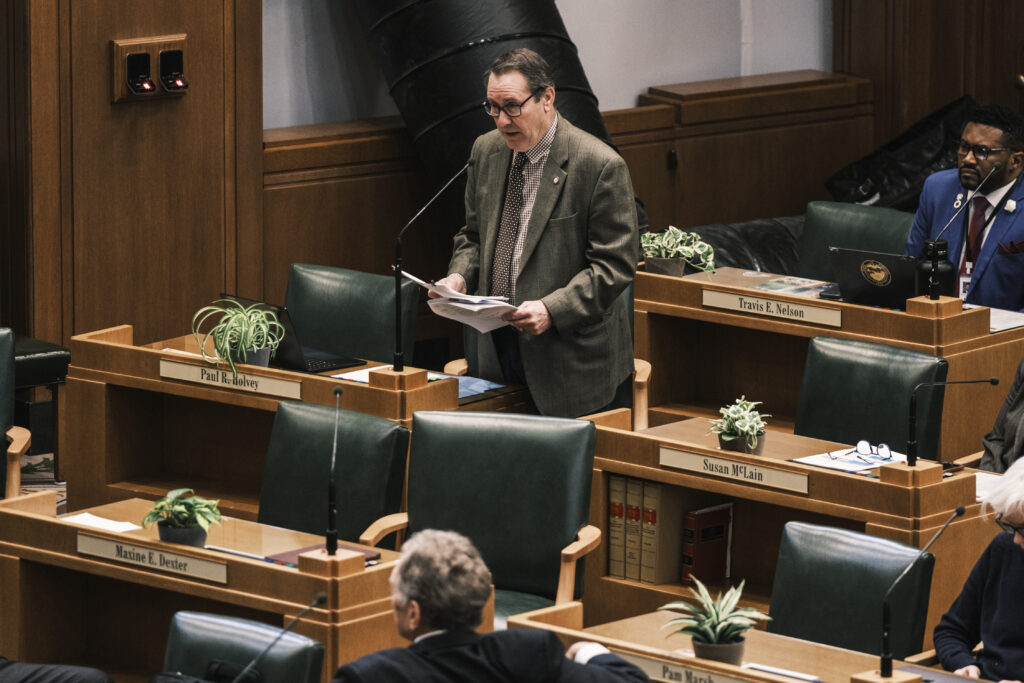The Legislature can’t impeach officials but the state does have a recall provision. Longtime Democratic Rep. Paul of Eugene easily survived an attempt in 2023. (Jordan Gale/Oregon Capital Chronicle)
Measure 115 on the November ballot is an unusual case.
It’s a straight-up question about the right way to remove a corrupt state official with no apparent target at stake. Oregon already allows certain officials to be recalled. Measure 115, referred to the ballot by lawmakers as a constitutional amendment, would allow the Legislature to impeach statewide elected officials, such as the governor, treasurer or secretary of state.
If passed, it would end Oregon’s outlier status as the only state in the nation that does not allow impeachment of these officials. It comes a year after the resignation of Shemia Fagan as secretary of state over a moonlighting scandal but is not aimed at any current official. Fagan resigned in May 2023 after news reports prompted an ethics investigation into her consulting work for the co-founder of a cannabis company that contributed to her campaign.
This is a question about how things should operate.
Impeachment, as a kind of emergency mechanism for ousting officials who are too incapable, corrupt or dangerous to be allowed to stay for the rest of their term, is a common approach in our nation. It’s available at the federal level to remove many top officials, including the president.
State legislatures in all other states are empowered to impeach really bad actors, though that doesn’t happen a lot. The proposed Oregon system is roughly similar to most of those. It would allow for impeachment by a two-thirds vote of the House for “malfeasance, corrupt conduct in office, willful neglect of constitutional duty or other felony or high crime,” with a conviction and ouster at trial by two-thirds of the Senate.
House Joint Resolution 16, which was behind Measure 115, had little trouble clearing the Legislature, and the limited written testimony was strongly in favor. A comment from Robert Leever of Lebanon caught the flavor: “Government without accountability is tyranny … plain and simple. Why should the government care about the concerns of all its citizens if the citizens have NO recourse.”
Moves in favor of giving the Legislature the ability to impeach an elected official picked up steam in 2023 with Fagan’s resignation over her $10,000-a-month side job for a cannabis company whose owner contributed $45,000 to her campaign. She took the job as state auditors were finishing up a review of oversight of the industry.
During legislative discussions of Measure 115, Republican Rep. Shelly Boshart Davis of Albany argued, “Recent events illustrate, yet again, the importance of having an impeachment procedure on the books as a check against negligence and abuse of power by public officials.”
Opponents did emerge, many focused on the idea of a partisan Legislature using impeachment to attack statewide officials of a different party or otherwise using it for abuse. The 49 states with impeachment provisions, however, have an extensive record of using them rarely and with caution.
A rare, specific argument against the impeachment amendment came from Republican state Senate candidate Noah Robinson of Cave Junction, who submitted an opposition argument to the state’s voter guide. He questioned whether the impeachment power might be used as a political club by one party against another.
He also asked a more philosophical question: “Our statewide officials are elected directly by the voters. The current system of requiring the voters to decide on a recall is better. Voters elect them, and voters should remove them if necessary.”
That raises a worthy question. Why not just rely on recall?
Oregon was one of the first two states, with Michigan in 1908, to approve the recall, and does allow for recall of governors. Not only that: The constitution says “Every public officer in Oregon is subject, as herein provided, to recall by the electors of the state or of the electoral district from which the public officer is elected.”
The problem is that the recall process is difficult and complicated, especially for higher offices.
First, you have to collect petition signatures – a lot of them. In the case of a statewide elected official, 15% of the total number of votes in the last election for governor in that official’s district is needed. At present, petition gatherers would need nearly 300,000 valid signatures to recall the governor, for instance. The process for generating a recall, and then scheduling an election, would take at least half a year and maybe longer.
Numerous attempts to recall former Governor Kate Brown – at least three in 2020 alone – which emerged rapidly enough that they melded into each other. But all failed, and none seem to have come close to reaching the ballot.
For some of these reasons, recall attempts above the local level rarely work. Only four recall elections of governors ever have been held, and just two of those – in California in 2003 and North Dakota in 1921 – resulted in the governor’s ouster. Incumbents survived two other attempts: California in 2021 and Wisconsin in 2012. Although Oregon has had the recall available for more than a century, no statewide officials ever have been recalled, and at least six attempts against former Gov. Kate Brown failed.
Impeachment probably would not happen a lot more often, either. But there is this to be said for having both on the books: If the Legislature decides not to act when it should, the voters have a fallback. From a voter standpoint, it’s a little bit of extra security if a statewide elected official turns out to be seriously bad.
GET THE MORNING HEADLINES.

